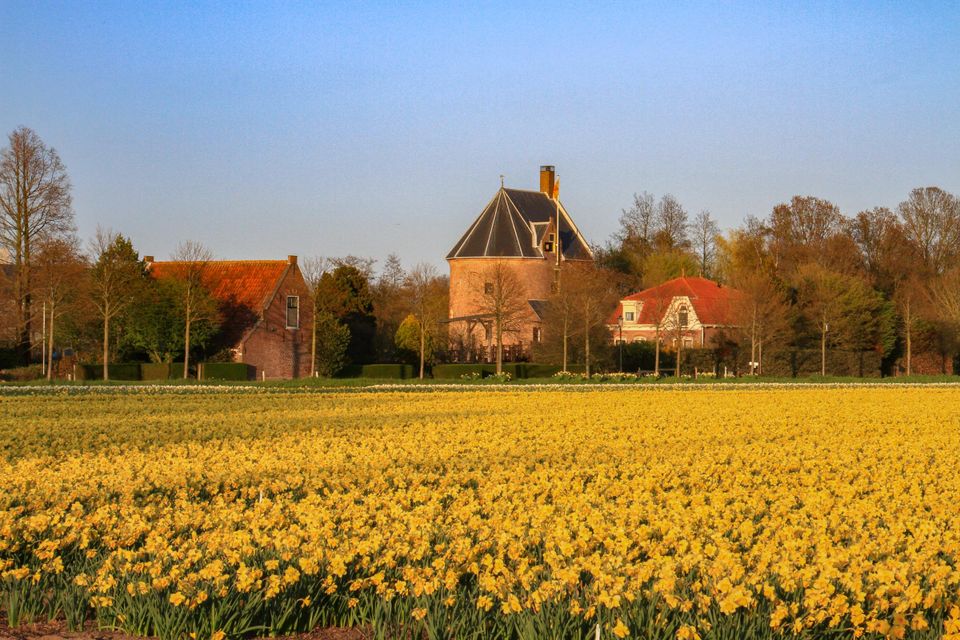Dutch Glory

Discover the past of the Bulb Region
This route is 49.40 km
Beautiful country estates, centuries-old castles and country manors with coach houses, orangeries and lush parks. This route takes you through part of the Country Estate Route in Zuid-Holland. This route takes you to the estates in the Bulb Region. The estates tell the story of the Golden Age and the Wig Period; the time when Holland was the richest country in the world. Well-to-do regents and merchants wanted to get out of the city in the summer and founded country estates on the sandy soil of the old line of dunes along the coast. Spending the summer in the fresh air, not too far from Haarlem, The Hague or Leiden, that was the idea. A small description of the estates, parks and castles can be found below.
T Huys Dever
Dever was probably built shortly after 1375 by Reinier Dever or d´Ever, a member of a very old family of Dutch nobles. The building is a so-called residential tower or donjon, a fortified residence, like many others that have stood in the coastal region; except for Dever they have all disappeared. Open Wednesday through Sunday from 2 to 5 pm.
Ruins of Teylingen
Teylingen Castle is a Dutch castle in the hamlet of Teylingen. It was probably the ancestral castle of the aristocratic family Van Teylingen, from which the house of Brederode was directly descended. Of the castle only the 'Ruïne van Teylingen' remains. It is well consolidated, consists of a ring wall and a donjon of which the ring wall is part, and is partly surrounded by water. The castle is a round water castle. Its most famous inhabitant was the Dutch countess Jacoba van Beieren. The castle was also the base of the troops of the Prince of Orange at the liberation of Leiden. The ruin can only be visited on a few days, for information see the website Kasteel Teylingen.
Park Rusthoff
Park Rusthoff is an urban park in the middle of the village center of Sassenheim. The old estate is still very recognizable. The park was completely restored to the English landscape style in 2001 and is freely accessible every day. In the park you will find a petting zoo, a park pavilion, a botanical garden and school gardens. Buitenplaats Huys te Warmont: Huis te Warmont is a castle-like building on the edge of Warmond in the province of Zuid-Holland. It is a late 18th century "buiten" that was once inhabited by the lords of the free manor of Warmond. Today the house is privately occupied and not open to the public. The park in which the house is situated has beautiful old oak lanes, winding paths, water features, open spaces and views to the Kaag. Hidden in the forest is the orangery with a rose and herb garden. The park is open daily.
Oud-Poelgeest Estate
Oud-Poelgeest Castle is located in Oegstgeest. The castle originated shortly after 1300 as a fortified house in an area 'surrounded by swamps and pools'. The castle is situated on an estate of over 10 ha. with hardwood forest, a pond and water streams on which also a coach house from the 19th century, a chapel, a gardener's house and a well can be found. The castle was built around 1640 in the current style and has had many owners. A famous resident of the castle was Leiden professor Herman Boerhaave around 1725. He planted special trees and crops on the estate and laid out a herb garden. The park is made up of avenues, lawns and wooded areas. The tree planting has grown monumentally over the centuries. The estate is known for its special wild spring bulbs, this very well developed stinzenflora is unique in South Holland. The park is open daily.
New Leeuwenhorst country estate
Nieuw Leeuwenhorst is situated on a beach ridge between Noordwijk and Noordwijkerhout. The country estate is characterized by stately beech and oak trees, the younger coppice forest, meadows and ponds. The area is rich in birds, bats and also fallow deer and roe deer can be found there regularly. Together with the country estates Klein Leeuwenhorst and Dijkenburg, it forms a very interesting and historically layered area with lanes, remnants of rhododendron groups and half-hidden bunkers. Count van Limburg Stirum commissioned the construction of a new house at Leeuwenhorst in 1880. This house was demolished in 1943 for the construction of a German tank trap. With the demolition of the house, a lifestyle of grand dinners and hunting parties also disappeared. The coach house and stables have been preserved. You can go for a walk on the estate every day.
T Hof van Hillegom
This estate dates back to the Middle Ages. In 1420 't Hof is mentioned for the first time, but the mansion is probably much older. The house was successively owned by families such as Van Nyenrode, Van Sypesteyn, Six and Van Waveren. The last heirs donated 't Hof in 1903 to the municipality of Hillegom with the intention of having these possessions serve as a lasting jewel and for the benefit of the community. In 1984 the new town hall was built on the Hof. The (Town) Hall is open from Monday to Wednesday and on Friday from 08.30 to 16.00
Keukenhof Castle
The name Keukenhof is derived from "Keukenduin" which belonged to Teylingen Castle. Adriaen Maertenszoon Block, a former commander of the United East India Company, had his house built in the Keukenduin in 1640. At that time the castle did not have any towers, but still the beautiful rooms on the second floor must have made a big impression on visitors. In the centuries that followed, the estate continued to grow.
A design by architect Elie Saraber transformed the seventeenth-century residence around 1860 into a neo-Gothic castle with all kinds of towers. Through the female line, the manor remained in the family in the years that followed, which is well seen in the manor: furniture from all kinds of years and style periods can be found in the various salons. The beautiful interior - which has been preserved in its entirety - shows how the nobility used to live. In 1840 the park was redesigned by the garden architects Zocher and Zn., who later also designed the Vondelpark in Amsterdam. They were inspired by the English landscape: the hills and winding roads are characteristic of that type of landscape.
Since the last lord of the Keukenhof estate, Count J.C.E. van Lynden, passed away in August 2003, the Keukenhof Castle Foundation has been responsible for the maintenance and exploitation of the estate. At the end of 2011, the finishing touches were put on a major restoration of the castle. The nearby historic buildings and the surrounding park have also been restored to their former glory. Keukenhof Castle is now once again the country estate of yesteryear, a place for a pleasant break, to enjoy culture and nature and to meet friends and acquaintances.
We wish you a pleasant bike ride and let you be surprised by all the beauty that reminds us of a glorious time!
